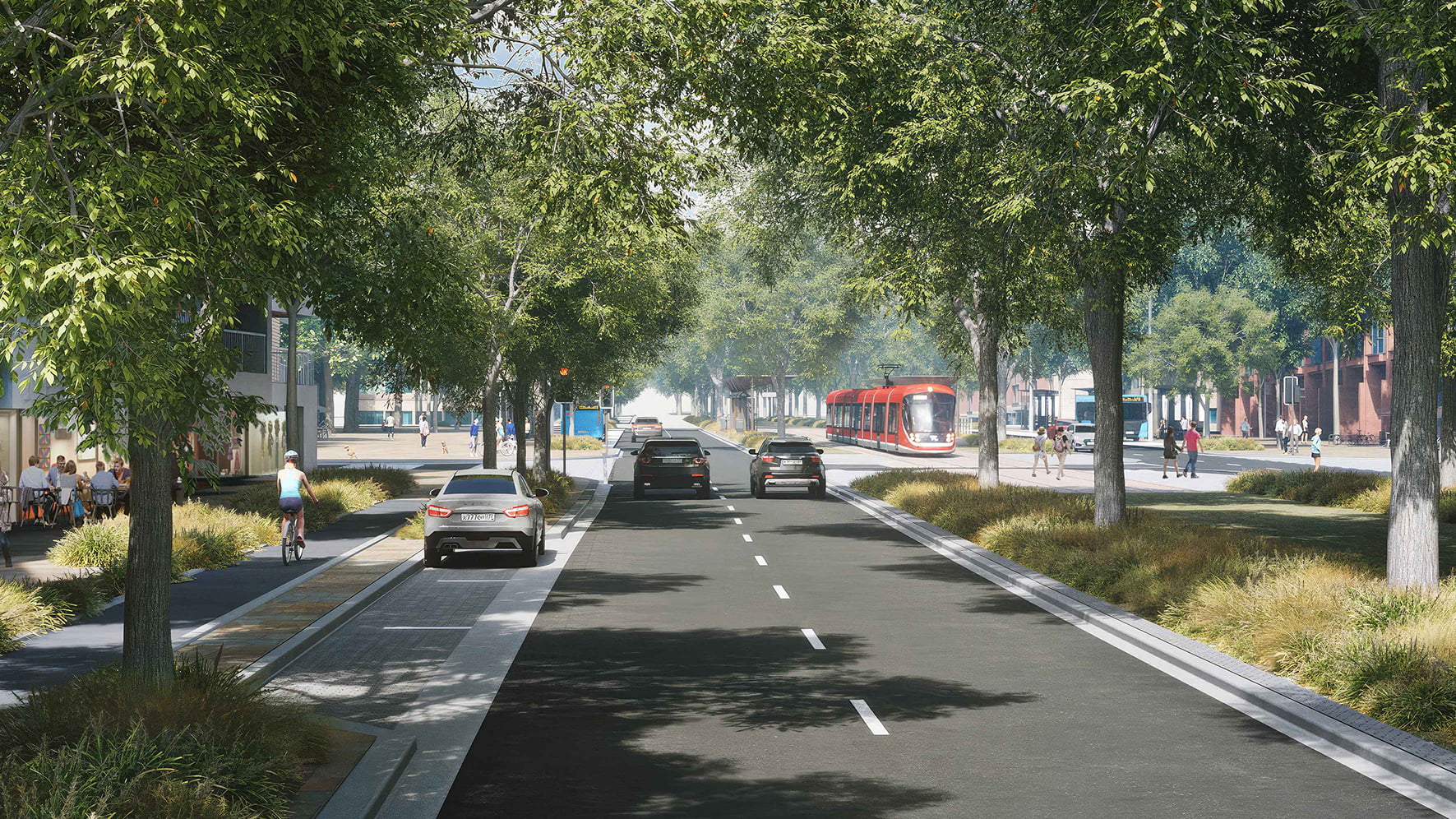
Just prior to the 2020 Christmas and New Year break, a development application (DA) was lodged and notified on the ACT Government’s Planning website. It was one of many DAs notified that month, but this one was special. It was for Canberra’s second most significant infrastructure project after light rail – the new, high-level, dual carriageway Molonglo River Bridge.
For residents of the Molonglo Valley – Canberra’s newest “greenfield” district – this was a welcome development. Since the first residents moved in eight years earlier, the only way to cross the Molonglo River west of the Tuggeranong Parkway was via the narrow, low-level and flood-prone Coppins Crossing. The delivery of the new bridge was a key commitment from ACT Labor at the 2020 ACT Election held two months earlier, and funding from the Federal Government had been announced that same month. This DA was a clear sign that the project was finally moving ahead.
Three years later, construction has officially commenced on the Molonglo River Bridge project, with completion due in December 2025. This has come as a relief to the 12,000 or so current residents of Molonglo, who have put up with multiple flood-related closures of Coppins Crossing over the intervening years. The lack of visible progress on this project had become a growing source of frustration in the local community.
For many, none of this information is new or surprising. But this article is about a different aspect of the Molonglo River Bridge project. This is about PTCBR’s multi-year long efforts to hold the ACT Government accountable for their stated policy of supporting public and active transport, how part of the battle was won thanks to a Ministerial intervention, and one critical element that still hangs in the balance.
This is a story about why PTCBR’s advocacy matters, and how you can can help secure better transport and land use outcomes in our city.
Molonglo’s transport future
From PTCBR’s perspective, the bridge itself is not the most interesting part of the Molonglo River Bridge project. It also features two new intersections and 1.7 kilometres of approach roads, completing the Molonglo Valley’s key north-south road, John Gorton Drive. Part of this project also interfaces with the future Molonglo Town Centre, which will be the main commercial, community and retail hub for the Molonglo Valley and its eventual population of 70,000 residents.
The below graphic, compiled by PTCBR using publicly available information, illustrates how the Molonglo River Bridge (shown in green) fits into the broader development context of the Molonglo Valley as it exists currently in 2024, including the future Molonglo Town Centre (outlined in dashed red).
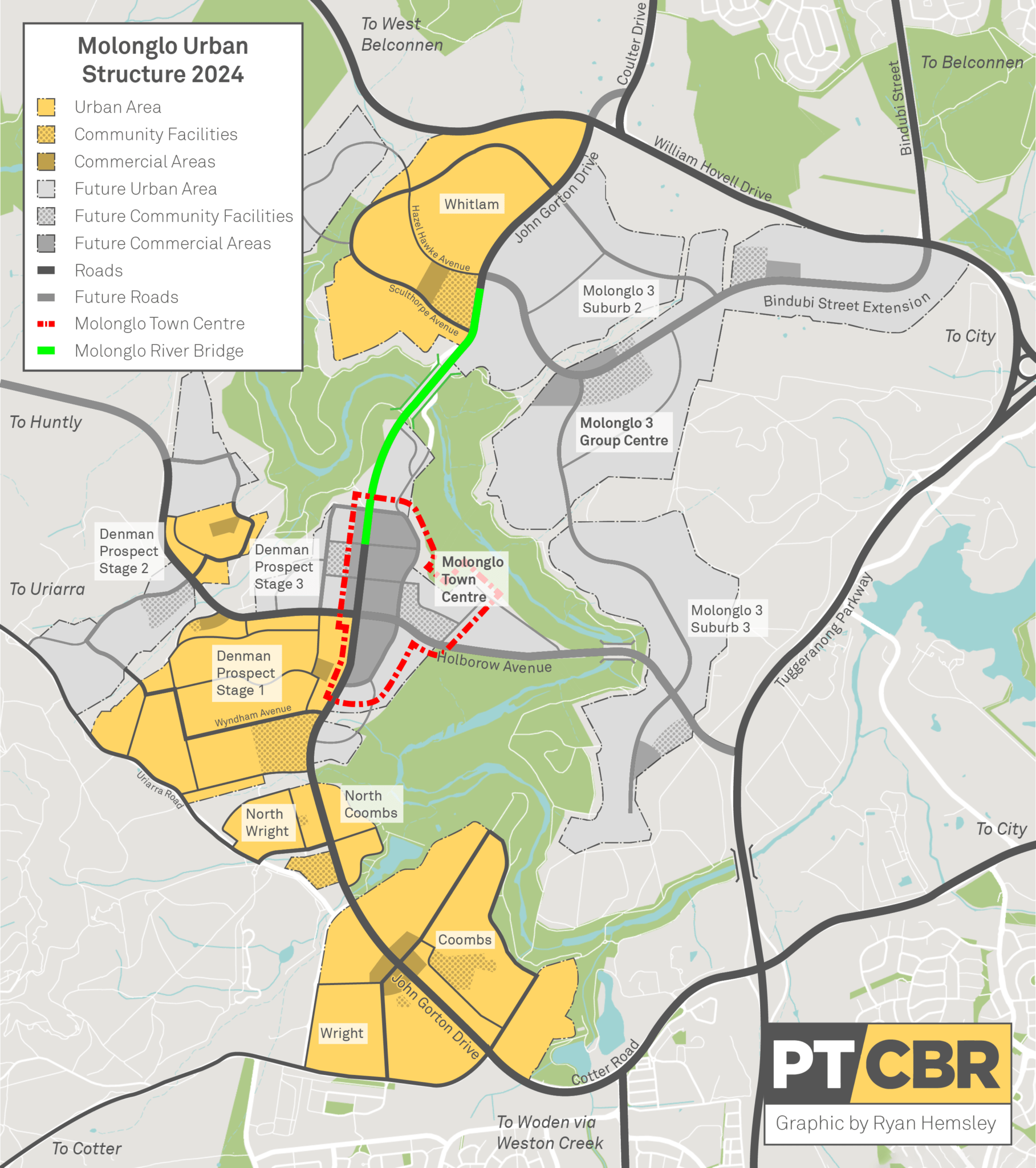
Critically, John Gorton Drive forms part of Molonglo’s inter-town public transport corridor. It is envisioned that the long-term transport needs of the district will be met in part by two rapid bus routes operating along John Gorton Drive and the future Bindubi Street Extension. One of these routes will run from Molonglo to the City via Parkes Way, and the other from Woden to Belconnen via Weston Creek and Molonglo. Modelling done in 2015 suggests buses could be running every one minute and forty-three seconds along this key transport corridor.
The two maps below illustrate one possible future in 2041. They are derived from key ACT Government transport planning documents, including the 2009 ACT Strategic Public Transport Network Plan and the 2012 Transport for Canberra policy. A detailed explanation for this specific choice of rapid routes is provided in Chapter 14 of the original edition of Jarrett Walker’s book “Human Transit”.
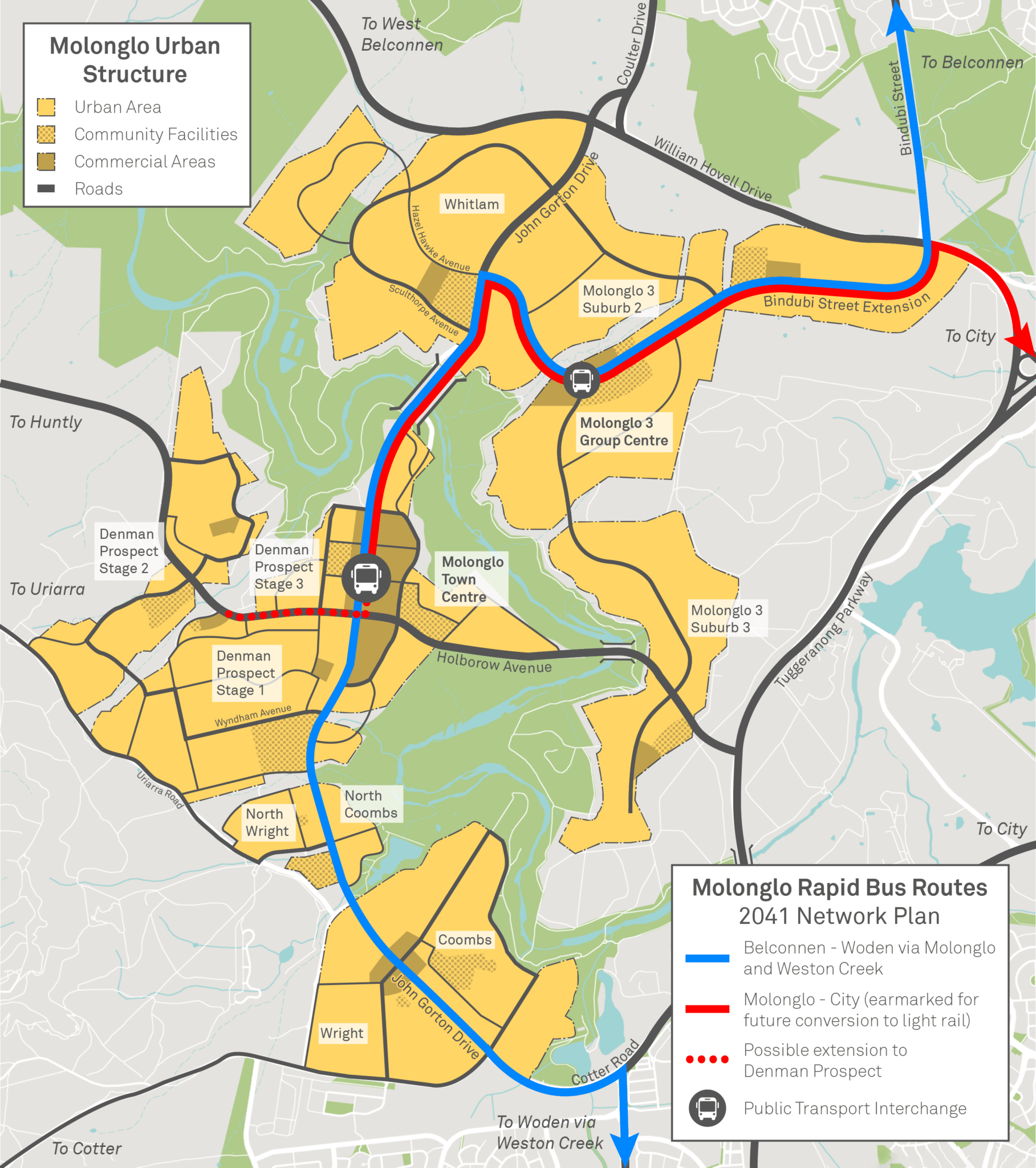
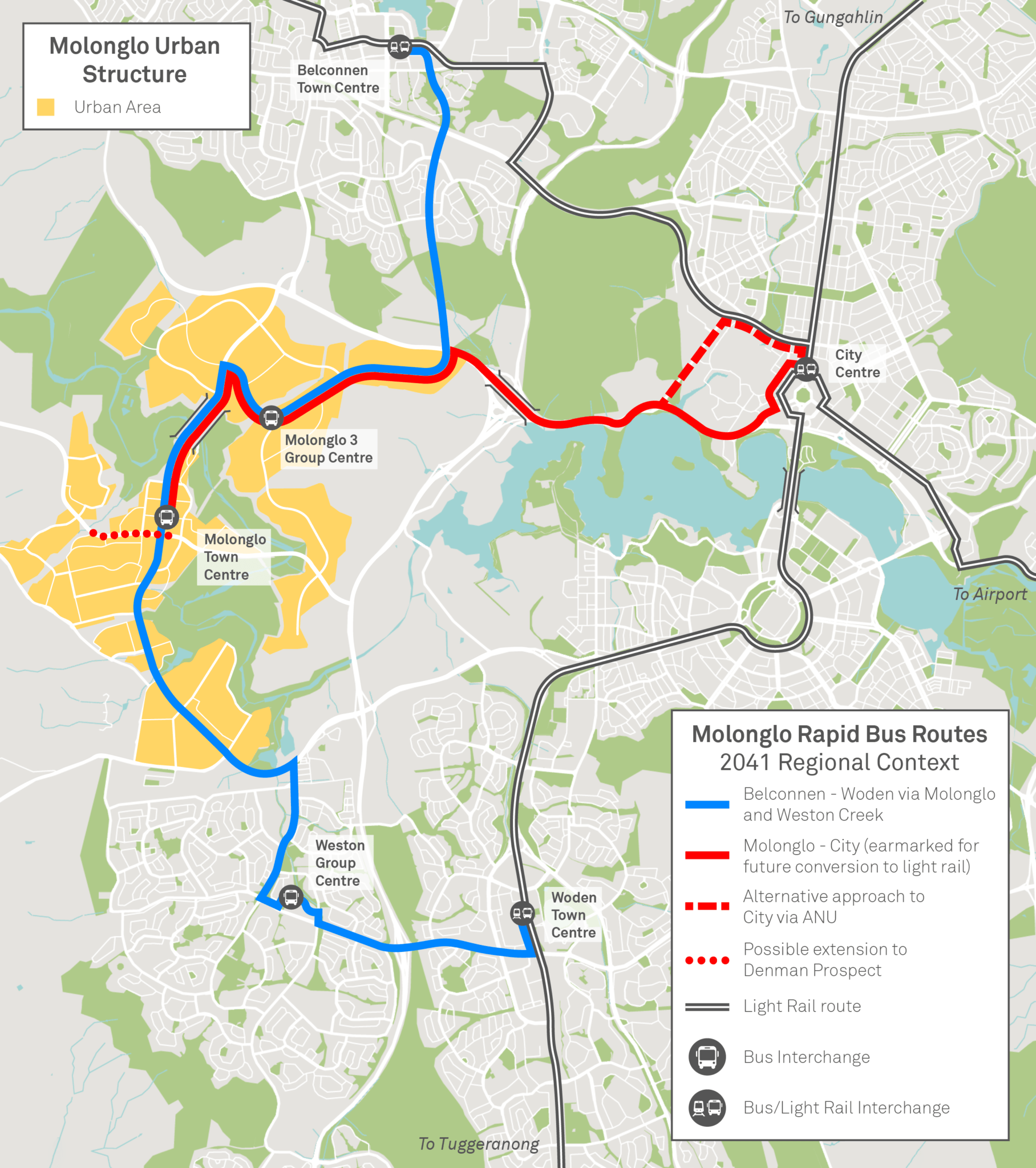
It was this aspect of the Molonglo River Bridge project that led PTCBR to meet with ACT Senator Zed Seselja in November 2019 and successfully advocate for a Federal Government funding contribution.
However, upon closer inspection of the DA documentation, it was immediately obvious to PTCBR that this latest and final stage of John Gorton Drive (Stage 3C) had been developed without any consideration for its role as a future inter-town public transport corridor, or as an address frontage for the future Molonglo Town Centre.
What was proposed was instead a bog-standard arterial road in the vein of Hindmarsh Drive, featuring slip lanes, unprotected on-road cycle lanes, a design speed of 80km/h and no public transport priority infrastructure. The documentation ignored the bus jump lanes built as part of the first two stages of John Gorton Drive, claiming (incorrectly) that since none had been provided elsewhere along the corridor, they weren’t needed here. It was a clear case of “moto-normativity” in action.
By giving primacy to private motor vehicles at the expense of literally every other mode of transport, the DA promoted a road user hierarchy that was blatantly contrary to established ACT Government policy, as outlined in the ACT Infrastructure Plan 2019, the ACT Planning Strategy 2018, the ACT Climate Change Strategy 2019-25 and the ACT Transport Strategy 2020. Lip service was paid to future-proofing for light rail, but as can be seen on page seven of PTCBR’s submission to the DA, this would still have required substantial modifications to the roadway, and was no excuse for not continuing the pattern of bus priority that had been provided in earlier stages of the corridor.
The submission also detailed why, in light of forecast traffic congestion, these priority measures will be necessary to protect the speed and reliability of bus services through the Molonglo Valley.
The lack of bus priority wasn’t the only feature present in previous stages of John Gorton Drive that was missing from this latest stage. PTCBR’s submission also drew attention to the DA’s disregard for the established street design of John Gorton Drive as it passed through the future Molonglo Town Centre. While these existing sections of road (Stage 2A) featured parallel parking bays, extra landscaping, “precinct style” lighting and a lower speed limit, the DA treated its own town centre-adjacent section as if it were a continuation of the bridge section, including the design speed of 80km/h.
The inevitable outcome of this approach would have been a repeat of the situation on Northbourne Avenue, where a road environment designed for 70km/h had its speed limit reduced, but without any major design changes. The result is people being fined for driving to the conditions, and a backlash against a speed limit reduction that is otherwise entirely justifiable on pedestrian safety grounds.
In short, the original DA for the Molonglo River Bridge was a recipe for slow buses, angry drivers, injured cyclists and pedestrian fatalities. PTCBR’s submission sought to avert this outcome by recommending that two key design changes be required as conditions of approval:
- The intersections featured in John Gorton Drive Stage 3C should be modified to include public transport priority measures consistent with the design of John Gorton Drive Stages 1 and 2A.
- The section of John Gorton Drive Stage 3C adjacent to the Molonglo Group/Town Centre should continue the established urban design character of John Gorton Drive Stage 2A.
Unfortunately, neither of these conditions made it into the official Notice of Decision.
Ministerial intervention
While PTCBR’s submission to the Molonglo River Bridge DA had been ignored by the assessors at the ACT Planning and Land Authority, it did convince the one person best placed to shape the future of the project – the ACT Minister for Transport, Chris Steel MLA.
In an email to PTCBR on 16 February 2021, four days after the Notice of Decision had been issued, one of Minister Steel’s Senior Advisors confirmed that:
“A significant amount of public transport priority measures like those outlined in PTCBR’s submission will be included in the final design of the [Molonglo River Bridge] project that weren’t included in the version submitted as part of the DA.”
This was welcome news, and a testament to Minister Steel’s willingness to act on good faith community feedback. This advocacy success was reaffirmed two years later when the contract was signed with B.M.D. Construction to deliver the project, with a letter from the Minister to PTCBR explicitly stating that bus priority will be a feature of the final project design.
A curious person may wonder why it took the lobbying of a public transport users group (with support from the ACT Greens transport spokesperson) to secure design changes which should have been included in the project from day one. Nevertheless, the outcome was the right one, and PTCBR are proud to have helped make it happen.
The saga continues
Steel’s welcome intervention on the bus priority measures still left one problem with the original DA unaddressed – the issue of the 80km/h road environment through the Molonglo Town Centre.
In the period between February 2021 and February 2024, a significant amount of planning work was done on Molonglo’s key commercial centre. This kicked off in October 2021 with an Opposition motion in the ACT Legislative Assembly calling for more detail on the form and timing of the centre. This saw the concept plan for the “Molonglo Group Centre” (as it was then called) tabled two months later. The concept plan was an update of the draft concept plan for the “Molonglo Commercial Centre”, which was completed in June 2014 but never released publicly.
Following a period of public consultation, the provisions from the December 2021 concept plan were incorporated into the Territory Plan in October 2022 via Technical Amendment 2022-01. This included:
- new intersections on John Gorton Drive to provide access to the centre (R14, C14 and C16)
- priority for public transport in the Molonglo Central precinct (C22)
- a local and rapid bus interchange, future-proofed for light rail (C20 and C21)
- a requirement that John Gorton Drive provide a “more urban character” as it passed through the commercial centre, with active uses facing public transport stops (C60) and protected cycle lanes (Figure 6).
The technical amendment provided long-overdue statutory weight to what PTCBR had called for the previous year – a road environment that appropriately balanced the traffic requirements of the centre with the safety and operational needs of public and active transport users. If the concept plan had been incorporated into the Territory Plan in 2014 when it was first drafted, PTCBR’s lobbying efforts would have been wholly unnecessary.
Where previously we had a road project with no plan, now we had a plan with no road project. Something needed to be done to translate the positive words of the concept plan into actual, built reality.
SLA to the rescue
The Suburban Land Agency (SLA) is the arm of the ACT Government responsible for delivering new residential, commercial and industrial developments across Canberra. In their own words:
“We create great places where communities thrive.”
The SLA are a separate entity from the ACT Government directorate responsible for planning and land management. They have their own board and report to the ACT Minister for Suburban Development, rather than the Minister for Planning. When it comes to the Molonglo Town Centre, their job is to take the approved planning framework, and get on the with job of delivering it through a combination of estate development and land sales.
The SLA are the successor agency to the former Land Development Agency (LDA), which was disbanded in 2017 after being plagued by governance and accountability issues. The LDA also had a poor reputation among Molonglo residents for bungling the sales process of the Coombs Shops. The SLA are understandably keen to avoid a repeat of these issues with the development of other commercial centres in the Molonglo Valley.
In September 2022, the SLA contracted two consultants (SMEC and Stuart Mackenzie Design) to undertake further design work on the 800 metre section of John Gorton Drive adjacent to the Molonglo Town Centre. The scope of this work (shown in dashed red) can be seen in the below graphic.
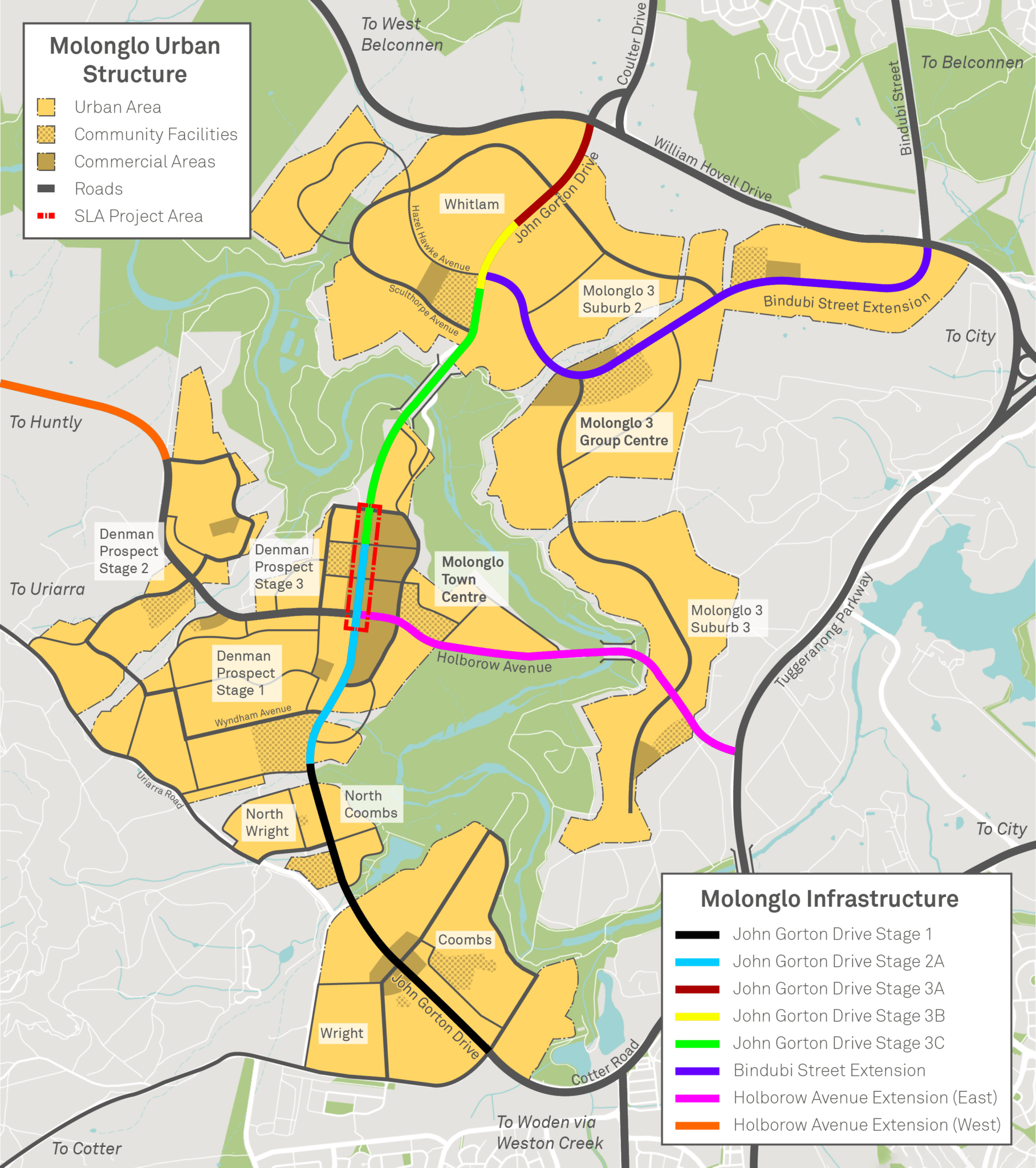
This design work has resulted in a magnificent new DA, with improved landscaping, protected cycle lanes, parallel parking bays, intersections into the town centre, a public transport interchange and additional space for future light rail. The project meets all the planning requirements introduced in the concept plan, while retaining the northbound bus “jump” lane incorporated into the bridge project following PTCBR’s 2021 advocacy efforts.
You can view all the DA documentation for the SLA’s project on the ACT Planning website.

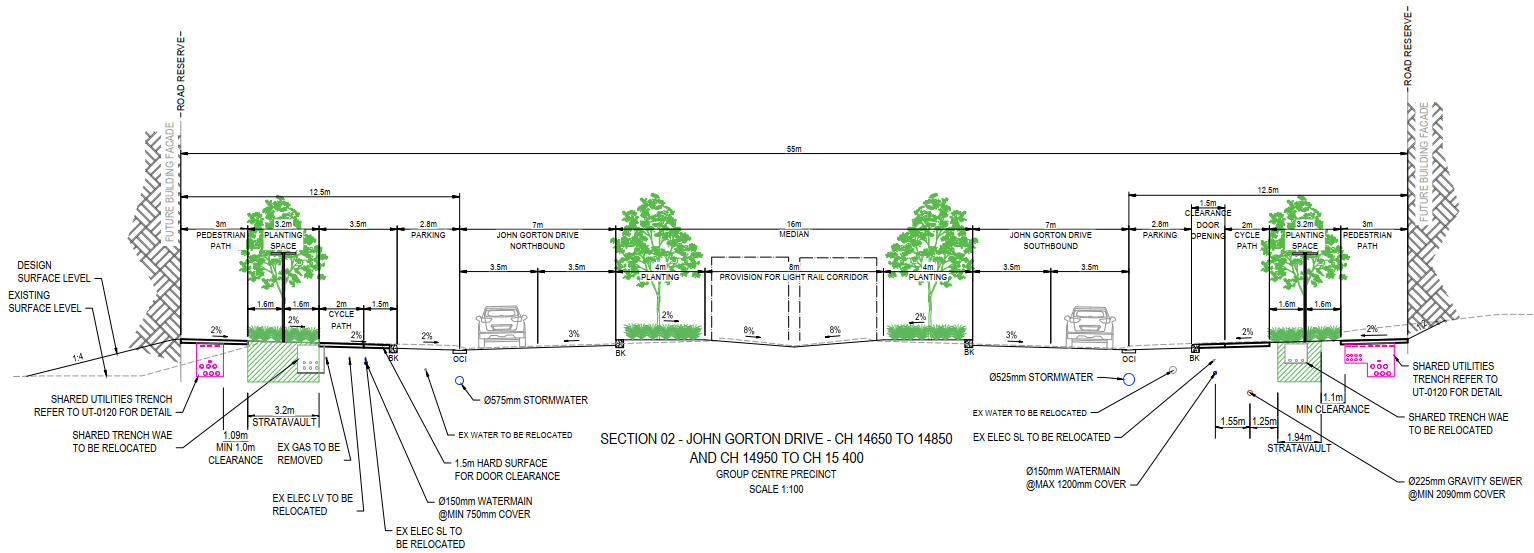
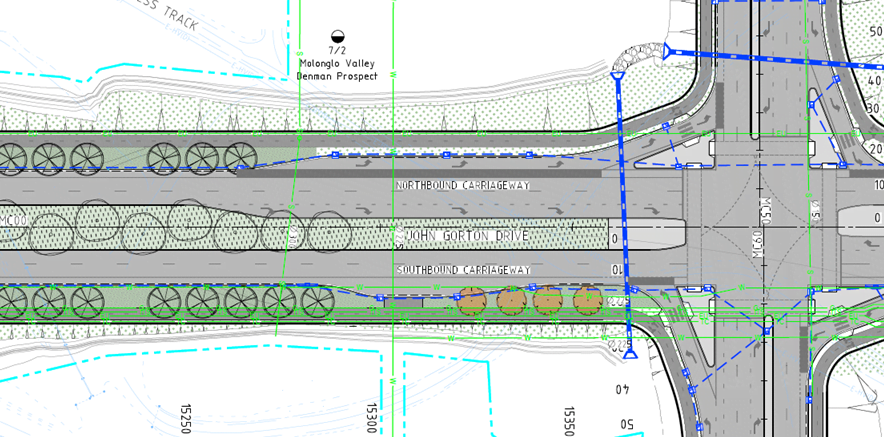
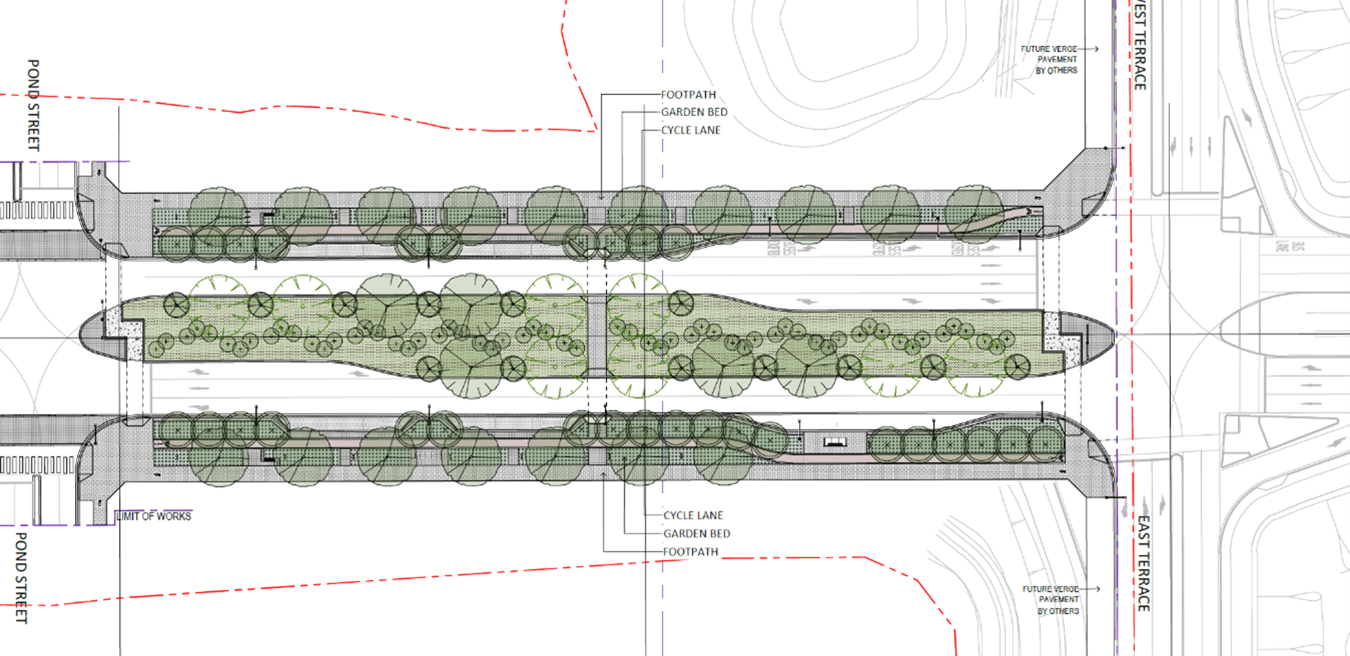
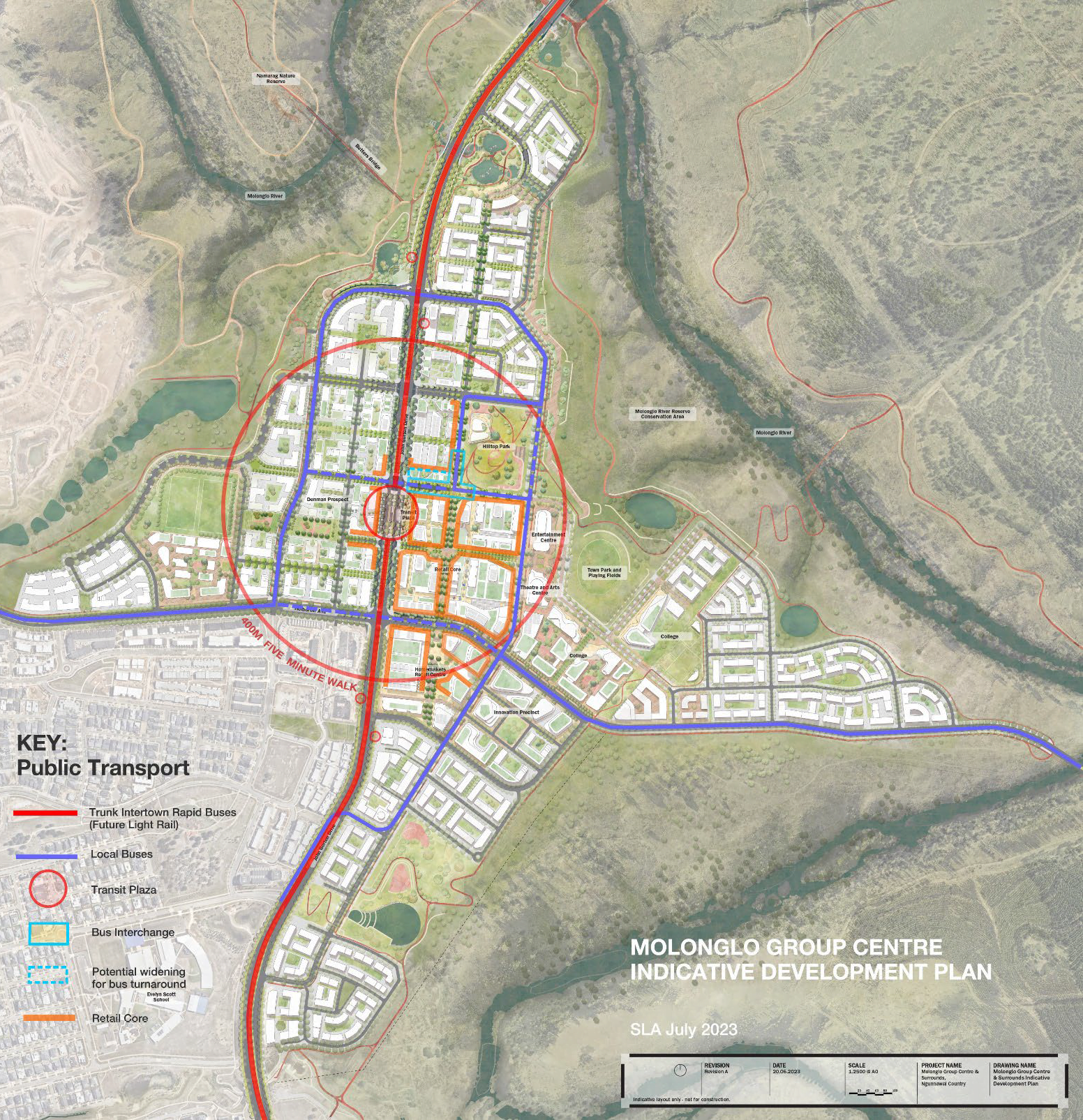

PTCBR understands the SLA will be delivering these upgrades via a separate but concurrent package of works to the Molonglo River Bridge project. This will minimise the total length of disruption associated with these projects, while also helping the government meet its ambitious land release targets for the Molonglo Town Centre, which have already been pushed back by several years.
After years of advocacy, it looks like a genuinely fantastic transport and land use outcome in the Molonglo Valley may finally be within reach.
The final hurdle
Of course, all this hinges on the DA for the SLA’s John Gorton Drive project being approved by the Territory Planning Authority. Despite meeting all the relevant planning requirements detailed in the concept plan, its approval is by no means guaranteed. Just one hostile officer at the Planning Authority or one of the mandatory DA referral entities could scuttle the whole endeavour, leaving the Molonglo Town Centre permanently severed by an 80km/h barrier of steel and asphalt.
If you want to show your support for the SLA’s John Gorton Drive streetscape improvement project, you can lodge a representation in favour of the DA (No. 202342442, Molonglo Section 2, Block 10) by completing this form: https://forms.act.gov.au/smartforms/servlet/SmartForm.html?formCode=1251 The period for submissions closes on 25 March 2024.
Aspects of the project you may wish to mention in your submission include:
- the improved safety outcomes for pedestrians and cyclists
- its role as critical enabling infrastructure for the future Molonglo Town Centre, and
- its consistency with the Molonglo Group Centre concept plan and the Design Guide for best practice urban intersections and other active travel infrastructure in the ACT.
PTCBR’s submission on the DA can be viewed here.
The ACT Government has made a big fuss about its new active travel plan and detailed design guide for “people-friendly streets” and safer intersections, which were both finalised earlier this year. The SLA’s John Gorton Drive project will be the first real test for the government, to see whether it has any intention of translating these positive words into built reality.
Stay tuned!